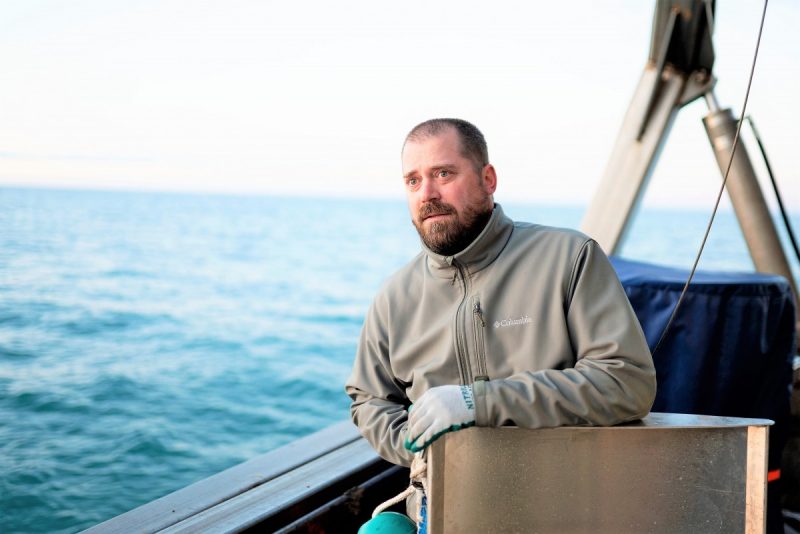
Optical measurement of a melt pond; Photo: Pierre Coupel
Synthesis study demonstrates phytoplankton can bloom below Arctic sea ice
New information emerges around algae blooms in low-light environments below sea ice
Small photosynthetic marine algae are a key component of the Arctic marine ecosystem but their role for the ecology of the Arctic Ocean have been underestimated for decades. That’s the conclusion of a team of scientists who synthesized more than half a century of research about the occurrence, magnitude and composition of phytoplankton blooms under Arctic sea ice. The results were published in a special issue of Frontiers in Marine Science devoted to Arctic Ocean research.
Phytoplankton are free-floating microscopic organisms, most of which are single-celled algae. Like terrestrial plants, they use photosynthesis to turn light into chemical energy by consuming carbon dioxide (CO2) and nutrients in the water. Phytoplankton are the basis of the marine food web and play a vital role in the carbon cycle by absorbing CO2 from the atmosphere.
Until roughly a decade ago, most scientists assumed that phytoplankton remained in a sort of stasis throughout the winter and spring until sea ice break-up. Now there is a growing body of evidence that suggests under-ice blooms (UIBs) of phytoplankton can occur in low-light environments below sea ice.
“Up to about a decade ago, most Arctic phytoplankton research focused on open water and ice-edge conditions as there was a long-running assumption that not enough light reached under the sea ice cover to allow for a bloom to occur,” explained CJ Mundy, co-author of the study and Associate Professor at the University of Manitoba’s Centre for Earth Observation Science (CEOS).
“However, this assumption was flawed in that under-ice phytoplankton blooms can and do occur during the melt period, and sometimes before melt if the ice and snow cover are thin enough.”

Associate Professor CJ Mundy onboard the R/V William Kennedy
The prior belief was that phytoplankton blooming in low-light environments below sea ice was uncommon.
“There was a long-standing assumption that what was happening under the sea ice in the water column was almost ‘on pause’ during the polar night and before seasonal sea ice retreat, which is apparently not the case,” said lead author Mathieu Ardyna, a postdoctoral fellow at Stanford University.
The revelation means that phytoplankton production in some regions of the Arctic Ocean may be an order of magnitude greater than originally predicted. That’s important for climate modellers who want to know how much atmospheric carbon is being absorbed by these algae.
Few places on Earth are transforming as rapidly as the Arctic due to climate change. Over the past 30 years, the Arctic has warmed at roughly twice the rate as the global average. One of the most visible signs of that change has been in the decline of the sea ice that floats on the ocean surface, with this year’s ice cover shrinking to the second lowest extent on record.
“It was fascinating to discover that so many regions of the Arctic Ocean provide a favorable habitat for these little algae to flourish when the sea ice cover is still present in late spring. It shows once more how vibrant the Arctic ecosystem is,” said Lisa Matthes, a PhD candidate at CEOS and co-author of the study. “But it also highlights that environmental changes induced by global warming affect all levels of the marine food web, from phytoplankton to polar bears,” she added.
It’s no surprise that the thinning ice cover has enabled phytoplankton, which require light for photosynthesis, to flourish. What was surprising to the researchers is that the phenomenon of UIBs occurred well before climate change affected Arctic sea ice.
“Digging up research that occurred from the ’50s and prior demonstrates that blooms, albeit not very large, were occurring under thick ice in the central Arctic,” he explained. “I think this fact surprised many of us, as models had suggested this was not the case.”
The historical observations included a pair of studies during the International Geophysical Year, a global campaign that ushered in the modern scientific era. The authors noted, “The end result of this work was nothing less than an incredible first glimpse of UIBs occurring in the central Arctic.”
The paper goes on to describe the variability among UIB events across the Arctic Ocean in terms of occurrence, magnitude, and even the type of organisms present. Some of those findings are based on scientific programs and expeditions dedicated to studying UIBs specifically. In many cases, observations relied on autonomous floats, robotic gliders and even remotely operated vehicles that can swim under the sea ice.
Ardyna said further observations to feed new computer models will be key to more accurately predict how the Arctic carbon cycle will change in the future.






